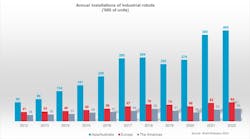Sponsored by SPIE—The International Society for Optical Engineering (Bellingham, WA; www.spie.org), the recent Photonics West 2002 trade show was successfully held in the San Jose Convention Center and Parkside Hall, Civic Auditorium Complex. Attendance totaled 14,674, including a record 6378 exhibit-only visitors. This turnout, reports Kathy Kincaid, Laser Focus World contributing editor, compares to 15,362 in 2001 and 12,116 in 2000. The 696 exhibitors were kept busy with more than expected floor traffic, and many said they were genuinely satisfied by the size of the show and the business optimism that permeated the exhibit hall.
According to Joe Hallett,Vision Systems Design contributing editor, the tragic events of last Sept. 11 are dramatically affecting the photonics industry, which provides key technologies that can be used to identify threats to the nation's security. Increased government and industry attention to security also means new business opportunities. In a special plenary presentation, director of the Office of Science and Technology Policy John Marburger, speaking on "Science and Engineering in the War Against Terrorism," told a Photonics West audience that photonics and its allied fields will continue to receive strong support from the Bush Administration. The real technical challenge, he said, is to deploy what we have effectively, rather than develop new technologies.
Exhibitors also expect to see increased government spending for homeland security, ranging from laboratory equipment to new applications for existing sensor technologies. And since both the effectiveness of inspections and the associated personnel costs are critical, research-and-development projects are exploring ways to reduce the amount of information that is presented to human inspectors.
Consider the case of screening for biohazards. Even though the suspect material may be as benign as fallout from a sugar donut, investigations are costly. "At the height of the scare, one location was averaging about 122 false alarms per day," says Michael Morris, president and cofounder ofOcean Optics Inc. (Dunedin, FL). "They were spending $5000 per sample just in paperwork, much less actual testing." The company's fiberoptic-based remote spectrometer technology attracted attention when the anthrax scare came along because the company was already working on the analysis of another organism that forms spores. "We were able to put together a system in about three days," says Morris, who demonstrated the system on the show floor. It consists of a pulsed xenon light source, a sample compartment, and a fiber going back to the spectrometer, which checks the spectra for a distinctive signature.
Indigo Systems (Santa Barbara CA) expects expanded applications for its line of (1- to 14-µm) infrared cameras. "We're seeing interest in applying this technology to things that people in the USA haven't been thinking about," says Jeff Frank, vice president of business development. "For example, pipelines can be monitored both at night and in the day by thermal-imaging technology. Airports have huge perimeter-security problems. Clearly, with hundreds or even thousands of cameras, there's more emphasis on networking and integrating into systems."
Surveillance cameras can be integrated into small, unmanned vehicles and placed on airplanes or on rooftops to observe people, gas plumes, or aerosols. "We're starting to see interest in near-infrared technology in the 1- to 1.7-µm band," says Indigo's Frank. "A camera can be combined with a liquid-crystal tunable filter to construct a spectrometer for chemical analysis." The company showed a prototype of its "Omega" miniature camera, a 3.5-in.3, 8- to 14-µm thermal imager with built-in signal processing that will be introduced next month.
National Instruments (NI; Texas) expects its market for laboratory products to grow, with more funding for optoelectronics, life sciences, and nanotechnologies. "Many customers are attaching fibers. That requires vision, measurement, and motion control," says Jason Mulliner, NI vision marketing manager. "People who already have our products are expanding their activities, Our customers have been involved with facial recognition and x-ray imaging. They have been addressing fatigue in human inspectors and ways to flag measurements for attention."
Mulliner also noted the emergence of support by theAutomated Imaging Association for Camera Link, a standardized interface for cameras and frame grabbers that should help vision system builders reduce cost and shorten lead times. The interface, which has its roots in flat-panel displays, can handle high frame rates.
Pixel Devices International Inc. (Sunnyvale, CA) showed its new low-noise CMOS-based LNL2048S sensors. "CMOS processing technology allows processing of sensor values at pixel sites where noise can be controlled," says cofounder Michael Godfrey. "It provides 12-bit, low-light imaging at the same speed as CCD sensors."
"We look for applications where low noise has high added value, such as for wafer-fab inspection," adds Godfrey. " Industrial and scientific areas are natural scanning applications where a linear imager is more convenient and cost-effective to use. But we will build an array sensor one day."
Homeland-security applications may demand more bandwidth and clear channels to manage data, along with the ability to dynamically reprovision communications networks by remote control in case of problems. "There are big problems with data susceptibility to crosstalk as channels get closer," says Tom Werner, chief executive officer ofSilicon Light Machines (SLM; Sunnyvale, CA). "Our devices are spectrally seamless, so channel separation doesn't matter."
The economic downturn may have come at a fortunate time for SLM, as it identifies potential new products for its microelectromechanical-system technology. More communications bandwidth is needed because of expanded Internet usage, and users want bandwidth to be available "on demand," according to Werner; the firm's licensing revenue provides some financial stability at a time when venture funding is hard to find.
One thing is certain. New national priorities are presenting significant changes and opportunities for many firms in the photonics industry.
Technology trendsAgilent Technologies Inc. (Palo Alto, CA; www.agilent.com) has developed the Agilent SP50 automated optical inspection system for checking solder-paste defects, such as pad offset and skew and solder-paste area, height, and volume, on printed-circuit-board assemblies. This inspection system continuously images boards by raster scan and makes accurate 3-D measurements of all solder deposits.Health-Scan Inc. (Bellevue, WA; www.health-scan.com) is offering computed-tomography colonography, also called virtual colonoscopy, to detect polyps or cancers in the colon by producing 2- and 3-D images on a computer. It also can be used for early detection of heart disease, lung cancer, and aneurysms.
Analog Devices Inc. (Norwood, MA; www.analog.com) has produced the AD7677 PulSAR 16-bit analog-to-digital converter (ADC) that is claimed to be twice as fast, twice as precise, and four times more power efficient than available devices. The fully differential 1-MSPS successive-approximation ADC is said to be accurate to one least-significant-bit integral nonlinearity, provides a 92-dB signal-to-noise distortion, and consumes 115 mW.
DVT Corp. (Norcross, GA; www.dvtsensors.com) has added web-enabled diagnostics and application sharing, called Doc, to its line of SmartImage Sensors Ethernet-ready machine- vision systems. The Doc feature permits secure global collaboration among multiple participants to make changes or add information to any SmartImage Sensor inspection running on any participant's machine.
Alliances accelerateViisage Technology Inc. (Littleton, MA; www.viisage.com) is a founding member of the Center for Identification Technology Research (CITeR; www.csee.wvu.edu/ citer) based at West Virginia University. The CITeR is a National Science Research Foundation Industry/University Cooperative Research Center that draws upon the interdisciplinary faculty expertise of West Virginia, Marshall, Michigan State, and San Jose State Universities.Management movesDalsa Corp. (Waterloo, Ont., Canada; www.dalsa.com) has agreed to acquire the semiconductor-foundry facility of Zarlink Semiconductor Inc. (Bromont, Quebec, Canada) for $21.6 million for an 80.1% ownership. Zarlink retains 19.9% ownership and remains a key customer. This facility will be renamed Dalsa Semiconductor Inc. Dalsa has also signed a term sheet for the purpose of acquiring the CCD image-sensors business of Royal Philips Electronics (Eindhoven, The Netherlands), which includes intellectual property, technology, assets, product lines, and employees. Moreover, Dalsa received a $4.5 million order for silicon image sensor chips from a major international imaging-system manufacturer.Cognex Corp. (Natick, MA; www.cognex.com) announced that the US Court of Appeals for the Federal Circuit ruled in its favor in an appeal related to Cognex's lawsuit against the Lemelson Medical, Education, & Research Foundation, Limited Partnership. The appeal ruling gives Cognex the right to raise the doctrine of patent prosecution laches, which bars a patentee from enforcing a patent claim when there was an unreasonable delay in seeking the claim from the Patent Office, as one of its defenses to the Lemelson Partnership's infringement claims. If Cognex is successful in arguing the laches defense when its lawsuit goes to trial in August 2002, the court could hold that the vast majority of the Lemelson patent claims, in many cases more than 30 years after the original 1954 and 1956 applications, are unenforceable.





